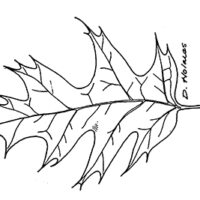 Purdue University - Extension - Forestry and Natural Resources
Purdue University - Extension - Forestry and Natural Resources
Got Nature? Blog
The classic and trusted book “Fifty Common Trees of Indiana” by T.E. Shaw was published in 1956 as a user-friendly guide to local species. Nearly 70 years later, the publication has been updated through a joint effort by the Purdue Department of Forestry and Natural Resources, Indiana 4-H, and the Indiana Department of Natural Resources, and reintroduced as “An Introduction to Trees of Indiana.”
The full publication is available for download for $7 in the Purdue Extension Education Store. The field guide helps identify common Indiana woodlot trees.
Each week, the Intro to Trees of Indiana web series will offer a sneak peek at one species from the book, paired with an ID That Tree video from Purdue Extension forester Lenny Farlee to help visualize each species as it stands in the woods. Threats to species health as well as also insight into the wood provided by the species, will be provided through additional resources as well as the Hardwoods of the Central Midwest exhibit of the Purdue Arboretum, if available. 
This week, we take a look at the sixth of our oak varieties in Indiana, the Northern Red Oak or Quercus rubra.
This native species is easily identified by its bark and its acorn. The bark looks like ski tracks or long running ridges that run up and down the sides of the tree, while the fruit is a large rounded acorn featuring a tight shallow cap with tight scales that resembles a beret sitting on top of a head.
Like other members of the red oak group, the leaves are multi-lobed and have bristle tips, including a sharp bristle tip on the terminal lobe. On the northern red oak, the alternately held leaves have veins that are palmate, or run out to the ends of the lobes from a single point in the middle. In the fall, the dark green leaves change to a bright red color.
The cluster of terminal buds at the end of northern red oak stems are smooth, shiny and reddish brown to brown in color. The twigs are somewhat angular in appearance.
Northern red oaks, which grow to 60 to 75 feet tall, are found mostly in upland areas. The natural range of northern red oak is the eastern United States and southern Canada, with the exception of the southern coastal plains. It grows well on moist, but well-drained soils.
The Morton Arboretum states that northern red oak has a high tolerance of salt and air pollution, making it a good tree for more exposed areas. This species prefers a well-drained, rich woodland site and it grows best in sandy, loam soil.
As with other oaks, the northern red oak should be pruned in the dormant season to avoid attracting beetles that may carry oak wilt. Galls and mites are common insect problems. This species can develop chlorosis symptoms in high pH soils.
For full article with additional photos view: Intro to Trees of Indiana: Northern Red Oak, Forestry and Natural Resources’ News.
If you have any questions regarding wildlife, trees, forest management, wood products, natural resource planning, or other natural resource topics, feel free to contact us by using our Ask an Expert web page.
Other Resources:
ID That Tree: Northern Red Oak
ID That Tree: Red Oak Group
Hardwood Lumber and Veneer Series: Red Oak Group
Morton Arboretum: Northern Red Oak
Red Oak, Native Trees of Indiana River Walk, Fort Wayne Purdue
Fifty Trees of the Midwest app for the iPhone, The Education Store
Native Trees of the Midwest, The Education Store
Shrubs and Woody Vines of Indiana and the Midwest, The Education Store
Investing in Indiana Woodlands, The Education Store
Forest Improvement Handbook, The Education Store
ID That Tree, Purdue Extension-Forestry & Natural Resources (FNR) YouTube playlist
Woodland Management Moment, Purdue Extension-FNR YouTube playlist
Wendy Mayer, FNR Communications Coordinator
Purdue University Department of Forestry and Natural Resources
Lenny Farlee, Sustaining Hardwood Extension Specialist
Purdue University Department of Forestry and Natural Resources

Recent Posts
- Hardwood Tree Log and Lumber Quality Workshop
Posted: May 10, 2024 in Forestry, Forests and Street Trees, How To, Woodlands - Take Your Turkey Fun Further – Wild Bulletin
Posted: May 9, 2024 in Forestry, How To, Wildlife - Paddle for Data – Wild Bulletin
Posted: in Aquaculture/Fish, Great Lakes, Ponds, Wildlife - IISG Adds New Water Safety Videos
Posted: May 8, 2024 in Aquaculture/Fish, Aquatic/Aquaculture Resources, Community Development, Great Lakes, Wildlife - Invasive Bradford-Callery Pear: Why it is so detrimental and what to plant instead
Posted: in Forests and Street Trees, How To, Invasive Plant Species, Urban Forestry - Trees and Storms – Mitigating the Damage
Posted: May 7, 2024 in How To, Urban Forestry - New Indiana Woodland Steward Newsletter, Your Forest and Wildlife Resource
Posted: in Timber Marketing, Wildlife, Woodlands - Farmers Helping Hellbenders RCPP Program Accepting Applications
Posted: May 1, 2024 in Aquaculture/Fish, Forestry, How To, Wildlife, Woodlands - Extension Specialist Brian MacGowan Receives Hoosier Wildlife Award
Posted: in Forestry, Wildlife - MyDNR – First positive case of chronic wasting disease in Indiana
Posted: April 29, 2024 in Alert, Disease, How To, Safety, Wildlife
Archives
Categories
- Alert
- Aquaculture/Fish
- Aquatic/Aquaculture Resources
- Ask the Expert
- Christmas Trees
- Community Development
- Disease
- Drought
- Forestry
- Forests and Street Trees
- Gardening
- Got Nature for Kids
- Great Lakes
- How To
- Invasive Animal Species
- Invasive Insects
- Invasive Plant Species
- Land Use
- Natural Resource Planning
- Nature of Teaching
- Plants
- Podcasts
- Ponds
- Publication
- Safety
- Timber Marketing
- Uncategorized
- Urban Forestry
- Webinar
- Wildlife
- Wood Products/Manufacturing
- Woodland Management Moment
- Woodlands